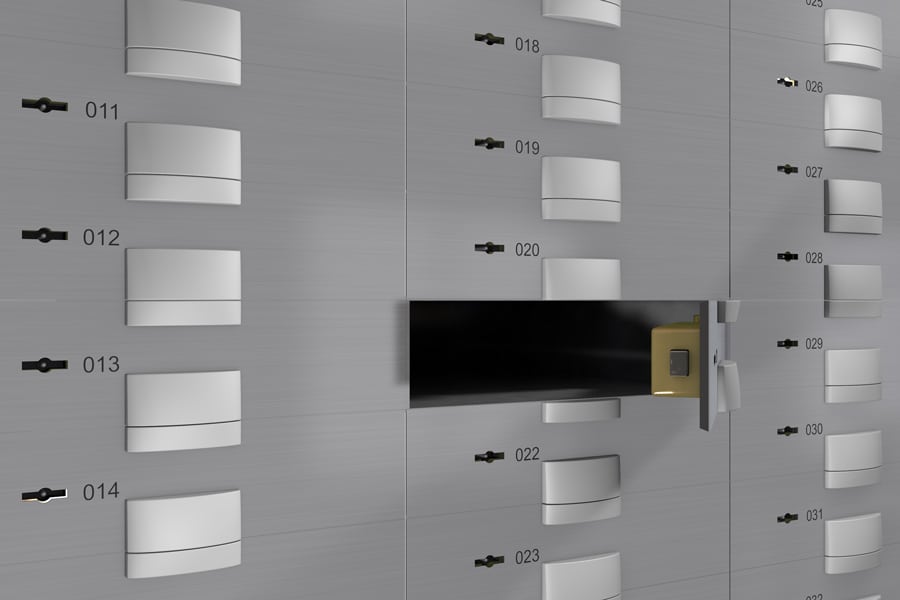Automatic versus manual systems
A fundamental distinction must be made here, as not every safe deposit locker system is the same. Automatic or electronic systems can be contrasted with manual, mechanical systems. In the latter case, the bank employee is involved in the process and opens the safe deposit locker for the customer.
On the other hand, the advantage of self-service for automatic systems sounds tempting. The fact is, however, that to a large extent it is manual safe deposit lockers which are still installed. The decisive question now is: how can existing mechanical systems be brought up to the latest technological standards?
Retrofitting instead of conversion
With the manual system, the employee always operates the first lock, the so-called “bank key”. The dual control principle and documentation are accordingly solved in an “organisational” way with person-related measures, and not “technically”. Apart from the time and cost aspect, the obligation to provide proof in the event of damage is often problematic.
Manual systems can of course be modernised by replacing mechanical safe deposit lockers with electronic ones. However, in practice this process is very complex. Safe deposit locker customers have to be contacted, and the rental contracts for the existing safe deposit lockers need to be renewed. The amount of work and time involved is considerable. This time-consuming process often results in additional costs, because if the customer fails to respond, the relevant safe deposit locker has to be opened professionally in the presence of a notary public.
The cost-benefit comparison when exchanging old rented safe deposit lockers for new ones is now much easier to demonstrate thanks to new technology. Instead of exchanging the existing safe deposit lockers, they can also be retrofitted. For this purpose sensors are installed on the existing boxes.
For this type of retrofitting it is not necessary to open the boxes. The modernisation process is correspondingly simple, as no locker needs to be emptied or re-rented.
Alarm and self-service functions for mechanical safe deposit lockers
Single compartment sensor technology (EFS) forms the basis for retrofitting. The result: alarm surveillance, audit security and self-service capability!
Branch structures, sales targets and employee scheduling often no longer allow for the accompaniment of customers renting safe deposit lockers for mechanical unlocking purposes. Individual safe deposit locker sensor technology not only makes manual safe deposit lockers more economical, but also ensures the safe operation of the mechanical system. Retrofitting existing systems with single compartment sensors and self-service technology also significantly improves the risk situation for bank staff. For the employee, not only is the time-consuming unlocking of the customer’s safe deposit locker no longer necessary. It is also no longer necessary to leave the customer area, and the dual control principle for compliance with the guidelines of the accident and robbery prevention insurers can be ensured.
This turns mechanical manual lockers into electronically monitored systems with efficient customer self-service (self-service retrofitting). “Upgrading with individual safe deposit locker sensor technology means that the actual security of the system is increased many times over”, confirms Kay-Tino Schönknecht, Managing Director of SAFECOR. The supplier for security and automation specialises in new technologies like these. “Every single locker is alarm-monitored and is only released individually after authorisation by the customer. Everything is electronically documented and the legal proof of who opened the locker and when is therefore always ensured”.
Basic security precautions
Even before the locker is opened, measures must be taken to ensure secure access controls and separation of individuals. To authorise access, the smartcard chip and PIN code are recommended. Separation of individuals prevents unauthorised access to the system. Innovative technologies are also available for retrofitting virtual personal turnstiles – without the need for costly construction measures. The OSDetect system in combination with individual safe deposit locker sensor technology ensures reliable controlled access.
However, the focus should not just be on IT security issues. The patch level of the software for the system controls, up-to-date encryption technology and data protection are important. But at least as important is the secure daytime door (access door) to the safe deposit facility. The safe door is open during daytime operation, i.e. the daytime door provides security in the self-service mode. It should therefore be designed as an RC2 security door.
Tampering is detected, the alarm is triggered – and then?
“Security is only as good as its weakest link,” explains Schönknecht. Therefore, in addition to IT and physical security, organisational aspects are also involved. Alarm reporting processes and the detection of technical manipulation have to be clearly defined. In this field experts like SAFECOR offer advice based on years of experience, ensuring that the conventional, manual safe deposit locker remains a secure facility for banks and their customers, even without complex conversions.

